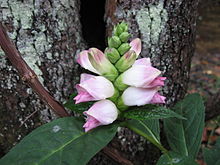Chelone glabra, or white turtlehead, is a herbaceous species of plant native to North America. Its native range extends from Georgia to Newfoundland and Labrador and from Mississippi to Manitoba.[1] Its common name comes from the appearance of its flower petals, which resemble the head of a tortoise. In fact, in Greek, chelone means "tortoise" and was the name of a nymph who refused to attend the wedding of Zeus and was turned into a turtle as punishment.[2] Its natural habitat is wet areas, such as riparian forests and swamps.[3][4]
| White turtlehead or balmony | |
|---|---|

| |
| Flowers | |
| Scientific classification | |
| Kingdom: | Plantae |
| Clade: | Tracheophytes |
| Clade: | Angiosperms |
| Clade: | Eudicots |
| Clade: | Asterids |
| Order: | Lamiales |
| Family: | Plantaginaceae |
| Genus: | Chelone |
| Species: | C. glabra
|
| Binomial name | |
| Chelone glabra | |
Its classification at the family level has in the past been controversial,[5] but as a result of DNA sequence studies, it is now regarded as belonging to family Plantaginaceae (the plantain family).[6] In early taxonomic treatments the species was divided into a number of subspecific categories but more recent studies indicate no morphological or genetic basis for these taxonomic categories. [11]
Description and ecology edit
This species has opposite, simple leaves, on stout, upright stems. The flowers are white, borne in late summer and early fall.
It is the primary plant on which the Baltimore checkerspot butterfly will lay its eggs (although the butterfly to some extent will use a few other species).[7][8]
Chelone glabra is a popular browse plant for deer.[4] It is also a foodplant for the sawflies Macrophya nigra and Tenthredo grandis (Hymenoptera: Tenthredinidae),[9] and a flea beetle in the genus Dibolia (Coleoptera: Chrysomelidae) has also been shown to feed on it.[10]
Uses edit
It has been used as a method of birth control by Abenaki people.[11][unreliable source?]
References edit
- ^ USDA, NRCS (n.d.). "Chelone glabra". The PLANTS Database (plants.usda.gov). Greensboro, North Carolina: National Plant Data Team.
- ^ Walker, Marilyn (2008). Wild plants of Eastern Canada : identifying, harvesting and using : includes recipes & medicinal uses. Halifax, N.S.: Nimbus Pub. ISBN 9781551096155. OCLC 190965401.
- ^ "Flora of the Southern and Mid-Atlantic States".
- ^ a b Williams, C (2000). "Use of turtlehead (Chelone glabra L.) and other herbaceous plants to assess intensity of white-tailed deer browsing on Allegheny Plateau riparian forests, USA" (PDF). Biological Conservation. 92 (2): 207–215. doi:10.1016/S0006-3207(99)00054-3.
- ^ "Changes in Taxonomy of Chelone glabra and the Traditional Scrophulariaceae (Figwort Family)".
- ^ "American Journal of Botany". doi:10.1002/(ISSN)1537-2197.
{{cite web}}: Missing or empty|url=(help) - ^ M. Deane Bowers, Nancy E. Stamp and Sharon K. Collinge (April 1992). "Early Stage of Host Range Expansion by a Specialist Herbivore, Euphydryas Phaeton (Nymphalidae)". Ecology. 73 (2). Ecological Society of America: 526–536. doi:10.2307/1940758. JSTOR 1940758.
- ^ Euphydryas phaeton (Drury, 1773) Archived 2010-09-06 at the Wayback Machine, Butterflies and Moths of North America
- ^ Stamp, N.E. (1984). Effect of defoliation by checkerspot caterpillars (Euphydryas phaeton) and sawfly larvae (Macrophya nigra and Tenthredo grandis) on their host plants (Chelone spp.). Oecologia 63:275–280.
- ^ Wilcox, J.A. (1979). Leaf beetle host plants in northeastern North America. World Natural History Publications, Kinderhook, NY.
- ^ "Plants Native to the State of Maine". Archived from the original on 2013-10-11. Retrieved 2013-08-05.
11. Allan D. Nelson; Wayne J. Elisens (1999). "Polyploid evolution and biogeography in Chelone (Scrophulariaceae): morphological and isozyme evidence". American Journal of Botany. Botanical Society of America. 86(10): 1487–1501. doi:10.2307/2656929. JSTOR 2656929. PMID 10523288.
External links edit
- Media related to Chelone glabra at Wikimedia Commons
- Connecticut Plants, Connecticut Botanical Society
